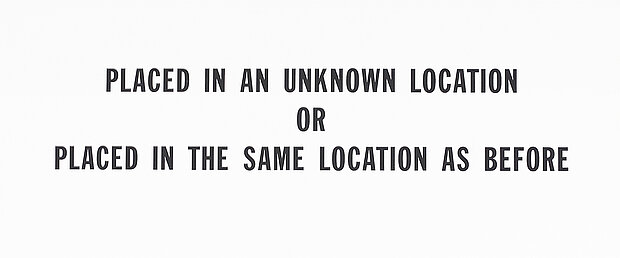
Weiner, Lawrence
PLACED IN AN UNKNOWN LOCATION OR PLACED IN THE SAME LOCATION AS BEFORE
1973

© mumok
| Object description | Text-Installation: PVC adhesive foil |
|---|---|
| Object category | sculpture |
| Dimensions |
Objektmaß:
height: 30 cm,
width: 146 cm
|
| Year of acquisition | 1997 |
| Inventory number | B 856/0 |
| Creditline | mumok - Museum moderner Kunst Stiftung Ludwig Wien |
| Rights reference | Bildrecht, Wien |
| Further information about the person | Weiner, Lawrence [GND] |
“PLACED IN AN UNKNOWN LOCATION OR PLACED IN THE SAME LOCATION AS BEFORE,” we read in large black letters on the wall. Lawrence Weiner‘s artistic material is language. Since the 1960s, Weiner’s work has consisted of single sentences or fragments of sentences to which he does not give any pre-defined material form. They are to be considered as proposals for ways we can enter into relationships with the objects and materials that surround us. Weiner himself sees his formulations as sculptures. He works on language like a sculptor with stone: “The fact is, they are sculptures, since they show the relationship of object to object and that is the idea and purpose of a sculpture.” Lawrence Weiner was born in 1942 in New York, and alongside Sol LeWitt or Joseph Kosuth he is seen as one of the main protagonists in American conceptual art. This movement questioned the material conditions of the work of art. The idea became the main feature, and not the implementation by the artist. This included the recognition that a work of art, just like our relationship to the world in general, is defined by language. In 1968, in his “Declaration of Intent,” which is valid to this day, Lawrence Weiner set out the basic principles of his concept of the artwork: “1. The artist may construct the piece. 2. The piece may be fabricated. 3. The piece need not be built. Each being equal and consistent with the intent of the artist the decision as to condition rests with the receiver upon the occasion of receivership.” In this way, the artist is relativizing his own role in the process of making art, seeing himself no longer as the sole creator, but giving third parties an active and productive role. Weiner said: “What makes art interesting is the fact that anyone can realize it as soon as the idea has been formulated. That’s the point.”
© mumok – museum moderner kunst stiftung ludwig wien